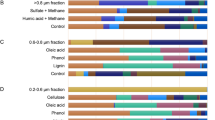Abstract
An anaerobic syntrophic bacterial culture degrading benzoate was isolated from a river sediment. The syntrophic organism was grown in coculture in the presence of a hydrogenotrophic strain,Desulfovibrio fructosovorans orMethanospirillum hungatei. The G+C content of the syntrophic benzoate degrader determined by density gradient ultracentrifugation was similar to that ofSyntrophus buswellii (54.3%). A method ensuring the G+C% determination of syntrophic bacteria is presented.
Similar content being viewed by others
Literature Cited
Cord-Ruwisch R (1985) A quick method for the determination of dissolved and precipitated sulfides in cultures of sulfatereducing bacteria. J Microbiol Methods 4:33–36
Ferry JG, Smith PH, Wolfe RS (1974)Methanospirillum, a new genus of methanogenic bacteria, and characterization ofMethanospirillum hungatii sp. nov. Int J Syst Bacteriol 24:465–469
Gribic-Galic D, Young LY (1985) Methane fermentation of ferulate and benzoate: anaerobic degradation pathways. Appl Environ Microbiol 50:290–297
Hungate RE (1969) A roll tube method for cultivation of strict anaerobes.In: Norris JR, Ribbons DW (eds), Methods in microbiology, vol 3B. London: Academic Press, pp 117–132
Imhoff-Stuckle D, Pfennig N (1983) Isolation and charaterization of a nictinic acid-degrading sulfate-reducing bacterium,Desulfococcus niacini sp. nov. Arch Microbiol 136:194–198
Lorowitz WH, Zhao H, Bryant MP (1989)Syntrophomonas wolfei subsp.saponavida subsp. nov., a long-chain fattyacid-degrading, anaerobic, syntrophic bacterium;Syntrophomonas wolfei subsp.wolfei subsp. nov.; and emended descriptions of the genus and species. Int J Syst Bacteriol 39:122–126
Mah RA, Xun LY, Boone DR, Ahring B, Smith PH, Wilkie A (1990) Methanogenesis from propionate in sludge and enrichment systems. In: Belaich JP, Bruschi M, Garcia JL (eds) FEMS Symposium No. 54. New York, London: Plenum Press, pp 99–111
Marmur J (1961) A procedure for the isolation of DNA from microorganisms. J Mol Biol 3:208–218
McInerney MJ, Bryant MP, Hespell RB, Costerton JW (1981)Syntrophomonas wolfei gen. nov., an anaerobic, syntrophic, fatty acid-oxidizing bacterium. Appl Environ Microbiol 33:1029–1039
Meselson M, Stahl FW (1985) The repliation of DNA inEscherichia coli. Proc Natl Acad Sci USA 44:671
Mountfort DO, Bryant MP (1982) Isolation and characterization of an anaerobic syntrophic benzoate-degrading bacterium from sewage sludge. Arch Microbiol 133:249–256
Mountfort DO, Brulla WJ, Krumholz LR, Bryant MP (1984)Syntrophus buswellii gen. nov. sp. nov, a benzoate catabolizer from methanogenic ecosystems. Int J Syst Bacteriol 34:216–217
Ollivier B, Cord-Ruwisch R, Hatchikian EC, Garcia JL (1988) Charaterization ofDesulfovibrio fructosovorans sp. nov. Arch Microbiol 149:447–550
Pfennig N, Widdel F, Trüper HG (1981) The dissimilatory sulfate reducting bacteria. In: Starr MP, Stolp H, Trüper HG, Balow A, Schlegel HG (eds) The prokaryotes, Vol 1. Berlin, Heidelberg, New York: Springer Verlag, pp. 926–940
Roy F, Dubourgier HC, Albagnac G (1986)Syntrophomonas sapovorans sp. nov., a new obligately proton reducing anaerobe oxidizing saturated and unsaturated long chain fatty acids Arch Microbiol 145:142–147
Stabineer H (1967) Une nouvelle méthode de mesure précise de la densité des liquides. Monoatsbeste. 98:436–438
Stich M, Schnik (1985) Anaerobic oxidation of fatty acids byClostridium bryantii sp. nov., a sporeforming, obligately syntrophic bacterium. Arch Microbiol 140:387–390
Szewzyk U, Schink B (1989) Degradation of hydroquinone, gentisate, and benzoate by a fermenting bacterium in pure or defined mixed culture. Arch Microbiol 151:541–545
Szybalski W (1968) Use of cesium sulfate for equilibrium density gradient centrifugation. Methods Enzymol 12 (Part B):330–360
Widdel F (1980) Anaerobater Abbau von Fettsäuren und Benzosäure durch neu isolierte Arten sulfat-reduzierender Bakterien. Thesis, University of Göttingen
Zhao H, Yang D, Woese CR, Bryant MP (1990) Assignment ofClostridium bryantii toSyntrophphospora bryantii gen. nov., comb. nov. on the basis of a 16SrRNA sequence analysis of its crotonate-grown pure culture. Int J Syst Bacteriol 40:40–44
Author information
Authors and Affiliations
Rights and permissions
About this article
Cite this article
Fardeau, ML., Ollivier, B., Soubrane, A. et al. Determination of the G + C content of twoSyntrophus buswellii strains by ultracentrifugation techniques. Current Microbiology 26, 185–189 (1993). https://doi.org/10.1007/BF01577375
Issue Date:
DOI: https://doi.org/10.1007/BF01577375




